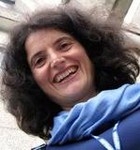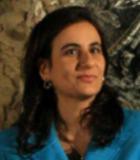Risultati: 4

Funzione/Ruolo
Professoressa ordinaria e Responsabile del laboratorio SENSOR all'Università di Brescia
Percorso professionale
Dopo aver conseguito la laurea in Fisica Sperimentale nel 1996 all'Università di Pisa, prosegue la sua formazione attraverso un dottorato di ricerca in Materiali per l'Ingegneria, presso l'università di Brescia, che consegue nel 2000. Dal 1999 al 2001 è tecnologa impiegata all'INFM (Istituto Nazionale di Fisica della Materia). Dal 2001 è ricercatrice in Fisica della Materia presso l'Università degli Studi di Brescia dove diventa in seguito professoressa ordinaria di Fisica Sperimentale della Materia.
Risultati scientifici
Elisabetta Comini è specializzata nello studio della crescita di ossidi metallici, in particolare nanofili, e nella misurazione delle loro proprietà elettroniche, funzionali e strutturali. È responsabile della linea di ricerca sulle "Metal oxide nanocrystalline quasi-1D structures" presso il laboratorio SENSOR (Università di Brescia e Istituto Nazionale di Ottica). Lo scopo del laboratorio SENSOR è quello di progettare e sviluppare nuovi materiali e processi produttivi per realizzare dispositivi e sistemi per applicazioni funzionali. Il laboratorio si dedica alla ricerca nell'ambito della Information and Communication Technology (ICT), nanomedicina, alimentazione e sicurezza. Uno dei settori di ricerca più avanzati del laboratorio è proprio quello diretto da Elisabetta Comini che si occupa delle nanostrutture di ossido quasi mono dimensionali: le nanostrutture cristalline 1-D stanno oggi emergendo come basi per una elettronica di nuova generazione e dispositivi optoelettronici in scala nanometrica con prestazioni superiori.
Attività editoriali e pubblicazioni
Elisabetta Comini è autrice di oltre 350 articoli peer-reviewed.
(2019) Nunez-Carmona E, Bertuna A, Abbatangelo M, Sberveglieri V, Comini E, Sberveglieri G. BC-MOS: The novel bacterial cellulose based MOS gas sensors MATERIALS LETTERS, 237 10.1016/j.matlet.2018.11.011
(2018) Zappa D, Galstyan V, Kaur N, Arachchige HMMM, Sisman O, Comini E. Metal oxide -based heterostructures for gas sensors. A review ANALYTICA CHIMICA ACTA 1039, 10.1016/j.aca.2018.09.020.
(2016) Kaur N, Comini E, Zappa D, Poli N, Sberveglieri G. Nickel oxide nanowires: vapor liquid solid synthesis and integration into a gas sensing device. Nanotechnology, 27(20).
(2015) Comini E, Galstyan V, Faglia G, Bontempi E, Sberveglieri G. Highly conductive titanium oxide nanotubes chemical sensors. Microporous and Mesoporus Materials, 208:165-170.
(2013) Comini E. Integration of Metal Oxide Nanowires in Flexible Gas Sensing Devices. Sensors-Basel, 13(8):10659-10673.
(2009) Comini E, Baratto C, Faglia G, Ferroni M, Vomiero A, Sberveglieri G. Quasi-one dimensional metal oxide semiconductors: Preparation, characterization and application as chemical sensors. Progress in Materials Sciences, 54(1):1-67.
(2007) Vomiero A, Ferroni M, Comini E, Faglia G, Sberveglieri G. Preparation of radial and longitudinal nanosized heterostructures of In2O3 and SnO2. Nano Letters, 7(12):3553-3558.
(2006) Ponzoni A, Comini E, Sberveglieri G, Zhou J, Deng SZ, Xu NS, Ding Y, Wang ZL. Ultrasensitive and highly selective gas sensors using three-dimensional tungsten oxide nanowire networks. Applied Physics Letters, 88(20).
(2004) Comini E, Guidi V, Malagu C, Martinelli G, Pan Z, Sberveglieri G, Wang ZL, Electrical properties of tin dioxide two-dimensional nanostructures. Journal of Physical Chemestry B, 108 (6):1882-1887.
(2002) Comini E, Faglia G, Sberveglieri G, Pan ZW, Wang ZL. Stable and highly sensitive gas sensors based on semiconducting oxide nanobelts. Applied Physics Letters, 81(10):1869-1871.
Riconoscimenti e premi
Nel Settembre 2005 vince il premio per la migliore presentazione alla conferenza EUROSENSORS XIX, a Barcellona. L'anno successivo, si aggiudica lo stesso premio alla conferenza EUROSENSORS XX a Goteborg. Nel 2010 vince il primo posto in Science as Art nell'ambito dell'MRS Spring Meeting a San Francisco. Due anni dopo si aggiudica l'Eurosensors fellow 2012, conferenza di riferimento per la comunità dei sensori.

Funzione/Ruolo
Professoressa ordinaria di Chimica presso l'Università di Bari
Percorso professionale
Dopo la laurea in Chimica presso l'Università di Bari nel 1993, prosegue la sua formazione con un dottorato di ricerca in Chimica nel 1996 e, fra il 1995 e il 1996, è Research Assistant del dipartimento di Chimica della University College London. Dal 1996 al 1998, tornata in Italia, svolge un post dottorato presso il Centro Studi Chimico Fisici sull'Interazione Luce-Materia del CNR, a Bari. Dal 1999 è ricercatrice del Centro Studi Chimico Fisici sull'Interazione Luce-Materia, l'anno successivo diventa ricercatrice a tempo indeterminato e dal 2010 è Prima Ricercatrice dell'Istituto per i Processi Chimico Fisici (IPCF) del CNR di Bari. Dal 2018 è Professoressa Ordinaria di chimica presso l'Unniversità di Bari.
Risultati scientifici
Maria Lucia Curri è attualmente responsabile per le attività di chimica dei materiali, volte a progettare, fabbricare ed elaborare solidi inorganici su scala nanometrica, all'interno dell'Istituto per processi Chimico Fisici di Bari. Istituto che svolge un'attività di ricerca interdisciplinare orientata alla valorizzazione, al trasferimento tecnologico e alla formazione su campi di ricerca quali materia soffice, materiali e sistemi complessi, compositi nanostrutturati, sistemi biomimetici, metodologie innovative e applicazioni multidisciplinari. Le attività principali di Maria Lucia Curri, condotte nell'ambito di progetti di ricerca nazionali e internazionali, riguardano la sintesi di nanoparticelle (ovvero particelle formate da aggregati atomici o molecolari con un diametro compreso fra 2 e 200 nanometri) con il controllo sulla forma, dimensione e fase cristallina, per regolare con precisione le loro proprietà chimico-fisiche e la loro funzionalizzazione. In questo senso importante è lo studio delle proprietà delle nanoparticelle colloidali fabbricate per valutare il loro potenziale utilizzo dei materiali nanostrutturati in campo biomedico, quali sistemi teragnostici per la diagnosi e la cura di patologie, nella conversione dell'energia e nel settore delle tecnologie ambientali, per l'abbattimento di inquinanti e la realizzazione di sensori. Di rilievo sono i risultati ottenuti nell'ambito delle applicazioni ambientali di semiconduttori nanostrutturati dal Progetto Europeo LIMPID sui "Materiali nanocompositi per la degradazione fotocatalitica di inquinanti", di cui è stata coordinatrice.
Attività editoriali e pubblicazioni
È co-autrice di più di 200 pubblicazioni e più di 180 articoli su riviste internazionali peer-reviewed e un certo numero di altre pubblicazioni, compresi 10 capitoli di libri.
Di seguito, una selezione:
(2019) Truppi A., Petronella F., Margiotta V., Lasorella G., Giotta G., Giannini C., Sibillano T., Murgolo S., Mascolo G., Agostiano A., Curri M. L. , Comparelli R. Gram-scale synthesis of UV–vis light active plasmonic photocatalytic nanocomposite based on TiO2/Au nanorods for degradation of pollutants in water Applied Catalysis B, 243, 604-613.
(2016) Valente G, Depalo N, de Paola I, Iacobazzi RM, Denora N, Laquintana V, Comparelli R, Altamura E, Latronico T, Altomare M, Fanizza E, Striccoli M, Agostiano A, Saviano M, Del Gatto A, Zaccaro L, Curri ML. Integrin Targeting with Peptide Bioconjugated to Semiconductor-Magnetic Nanocrystalline Heterostructures. Nano Research, 9:644-662.
(2015) Ingrosso C, Esposito Corcione C, Striani R, Comparelli R, Striccoli M, Agostiano A, Curri ML, Frigione M. UV-curable Nanocomposite based on Methacrylic-Siloxane Resin and Surface modified-TiO2Nanocrystals. ACS Applied Materials and Interfaces, 7:15494-15505.
(2014) Corricelli M, Depalo N, Di Carlo E, Fanizza E, Laquintana V, Denora N, Agostiano A, Striccoli M, Curri ML. Biotin-decorated silica coated PbS nanocrystals emitting in the second biological near infrared window for bioimaging. Nanoscale,6: 7924-7933.
(2013) Fanizza E, Depalo N, Clary L, Agostiano A, Striccoli M, Curri ML. A combined size sorting strategy for monodisperse plasmonic nanostructures. Nanoscale, 5(8):3272-82.
(2013) Placido T, Aragay G, Pons J, Comparelli R, Curri ML, Merkoçi A. Ion-Directed Assembly of Gold Nanorods: a Strategy for Mercury Detection. ACS Applied Materials and Interfaces, 5 (3):1084-1092.
(2010) Ingrosso C, Sardella E, Keller D, Dohn S, Striccoli M, Agostiano A, Boisen A, Curri ML. Surface functionalization of epoxy resist based microcantilevers with iron oxide nanocrystals. Advanced Material, 22:3288-3292.
(2009) Placido T, Comparelli R, Giannici F, Cozzoli PD, Capitani G, Striccoli M, Agostiano A, Curri ML.Photochemical Synthesis of Water-Soluble Gold Nanorods: the Role of Silver in Assisting Anisotropic Growth. Chemistry of Materials, 18:4192-4202.
(2009) Kim JY, Ingrosso C, Fakhfouri V, Striccoli M, Agostiano A,Curri ML, Brugger J. Multi-color inkjet printing of highly luminescent nanocrystal based nanocomposites. Small, 5:1051-1057.
(2007) Ingrosso C, Fakhfouri V, Striccoli M, Agostiano A, Voigt A, Gruetzner G, Curri ML, Brugger J. Luminescent nanocrystal modified epoxy photoresist for the fabrication of 3-D high aspect-ratio microstructures. Advanced Functional Materials, 17:2009-2017.
(2005) Comparelli R, Curri ML, Fanizza E, Cozzoli PD, Mascolo G, Agostiano A. UV-induced Photocatalytic Degradation of Azo Dyes by Organic-Capped ZnO Nanocrystals Immobilized onto Substrate. Applied Catalysis B: Environmental, 60:1-11.
Riconoscimenti e premi
Maria Lucia Curri ha ricevuto numerosi riconoscimenti per i suoi poster scientifici.
Nel 2000, premio della Società Italiana di Chimica "L. Senatore" per il poster ”Chemical and physical characterization of hybrid structures based on in organic nanocrystalline semiconductors and semiconducting polymer for opto-electronic applications”
Nel 2002, il poster “Colloidal oxide nanoparticles for the photocatalytic degradation of organic dyes” viene riconosciuto come il migliore all'E-MRS Spring Meeting di Strasburgo.
Nel 2003, il poster "TiO2 nanocrystals -conjugated -polymer thin film for photovoltaic application" viene riconosciuto come il migliore all'E-MRS Spring Meeting di Strasburgo.
Nel 2004, il poster “Hybrid organic nanocomposites based on semiconducting colloidal quantum dots in polymers” viene riconosciuto come il migliore all'E-MRS Spring Meeting di Strarsburgo.
Nel 2006, premio della Società Italiana di Chimica "L. Senatore" per il poster “Optical and morphological properties of hybrid nanocomposite based on colloidal TiO2 nanocrystals in polymer”.
Nel 2017, il poster “Drug Delivery Nanovectors Based on SPIONS for Targeted Therapy of Hepatocellular Carcinoma” riceve la nominatin per il miglior poster all'IEEE NEMS 2017 di Los Angeles, Stati Uniti.

Funzione/Ruolo
Ricercatrice CNR, Responsabile del Laboratorio di Crescita Epitassiale (MOVPE ed MBE) dell'Istituto per la Microelettronica e Microsistemi (IMM) del CNR (sede di Lecce), Responsabile Scientifica per l'IMM delle attività di ricerca della Rete di Laboratori Pubblici di Ricerca PHASHYN
Percorso professionale
Dopo la laurea in Fisica nel 1991 all'Università degli Studi di Lecce, prosegue la sua formazione attraverso un dottorato di ricerca in Fisica, presso l'Università degli Studi di Bari, conseguendone il titolo nel 1996. Nel settembre 1996 vince una posizione post-dottorato per un anno in Galles, Gran Bretagna, presso il North East Wales Institute (NEWI), adesso Glyndwr University. Dal marzo 1998 è ricercatrice in Fisica della Materia presso l'IMM (Istituto per la microelettronica e i Microsistemi) del CNR, sezione di Lecce. Nel 1996/97 è docente presso diverse istituzioni straniere in Gran Bretagna, nell'ottobre 1998 Visiting Scientist presso la Chiba University, Chiba, Giappone e dal 1997 al 2011 professoressa a contratto presso la Facoltà di Ingegneria dell'Università del Salento. È relatrice di numerose tesi di laurea e dottorato.
Risultati scientifici
Le competenze di Paola Prete riguardano lo studio della crescita di materiali semiconduttori composti, in particolare nanofili, e delle loro proprietà ottiche, morfologiche e funzionali. In particolare, lo studio della sintesi di materiali semiconduttori mediante tecnologie epitassiali (da fase vapore, MOVPE e da fasci molecolari, MBE), lo studio delle proprietà fisiche, chimiche e morfologiche attraverso tecniche di spettroscopia ottica (luminescenza ed assorbimento) e di microscopia elettronica (FE-SEM, catodoluminescenza).
La ventennale attività di ricerca di Paola Prete è iniziata con lo studio delle proprietà ottiche e strutturali di etero-strutture a bassa dimensionalità di semiconduttori per applicazioni optoelettroniche. Attualmente lavora nel campo delle nanotecnologie studiando ed impiegando le tecniche di sintesi bottom-up nella fabbricazione di nano-strutture quasi-1D per applicazioni ai dispositivi per la nano-optoelettronica, fotonica e sensoristica. Tra le attività di ricerca più recenti, di particolare rilievo è l'applicazione delle nanotecnologie alle energie rinnovabili, ed in particolare all'energia solare da fonte fotovoltaica, nell'ambito della Rete di Laboratori Pubblici di Ricerca PHASHYN. Le ricerche di Paola Prete mirano alla realizzazione di celle solari di III-generazione ad alta efficienza, costituite da nanofili, (nanocristalli di semiconduttori delle dimensioni di un virus, cioè dell'ordine di poche decine di milionesimi di millimetro). Le tecnologie che Paola Prete sta sviluppando a Lecce consentiranno di impacchettarne decine di miliardi per centimetro quadro: una tecnologia sofisticata e fruibile che potrà garantire, in un futuro non troppo lontano, incrementi sostanziali nel rendimento delle celle e costi di fabbricazione relativamente bassi. All'interno di questa tematica si inserisce anche lo studio della crescita epitassiale van der Waals di materiali 2-dimensionali (quali il grafene e i materiali ‘graphene-like'). Paola Prete fa parte del Comitato Consultivo e di quello Scientifico di diversi congressi internazionali. Iscritta all'Albo degli esperti dell'Agenzia Regionale per la Tecnologia ed Innovazione della Regione Puglia (A.R.T.I.), è valutatrice di progetti di ricerca, sviluppo precompetitivo e trasferimento tecnologico dell'ARTI Puglia.
Attività editoriali e pubblicazioni
Dal 2011 è fondatrice ed Editor-in-Chief della rivista scientifica open access "Nanomaterials and Nanotechnology", SAGE, USA (2016 Impact Factor 1.536).
Dal dicembre 2016 è anche Associate Editor della prestigiosa rivista "Progress in Crystal Growth and Characterization of Materials", Elsevier (2016 Impact Factor 3.4).
Editor di libri e Guest Editor di numerosi volumi internazionali e Special Issue su riviste scientifiche peer-reviewed quali "Progress in Crystal Growth and Characterization of Materials" (Elsevier), "Crystal "Research and Technology" (Wiley-VCH), "Applied Physics A: Material Science and Processing" (Springer).
È autrice di più di 120 pubblicazioni su riviste scientifiche nazionali ed internazionali, fra cui:
[2018] Wolf D, Huebner R, Niermann T, Sturm S, Prete P, Lovergine N, Buechner B, Lubk A, Three-Dimensional Composition and Electric Potential Mapping of III-V CoreMultishell Nanowires by Correlative STEM and Holographic Tomography. Nano Letters, 18 (8) 4777-4784.
[2017] Di Carlo V, Prete P, Dubrovskii V G, Berdnikov Y, Lovergine N, CdTe nanowires by Au-catalyzed Metalorganic Vapor Phase Epitaxy. Nano Letters, in stampa (pubblicato on-line 14 giugno, 2017), DOI: 10.1021/acs.nanolett.7b00719.
[2015] Bianco GV, Losurdo M, Giangregorio MM, Sacchetti A, Prete P, Lovergine N, Capezzuto P, and Bruno G, Direct epitaxial CVD synthesis of tungsten disulfide on epitaxial and CVD graphene. RSC Advances, 5:98700-98708.
[2015] Chen G., McGuckin T, Hawley C J, Gallo EM, Prete P, Miccoli I, Lovergine N, Spanier J E, Subsurface imaging of coupled carrier transport in GaAs/AlGaAs core-shell nanowires. Nano Letters, 15 (1):75-79.
[2015] Miccoli I, Prete P, Lovergine N, A mass-transport limited model describing the MOVPE growth of III-V shells around dense free-standing nanowire arrays. CrystEngComm, 17 (31): 5998-6005.
[2014] Lubk A, Wolf D, Kern F, Roeder F, Prete P, Lovergine N, Lichte H, Nanoscale three-dimensional reconstruction of elastic and inelastic mean free path lenghts by electron holographic tomography. Applied Physics Letters, 105 (17):173101.
[2013] Chen G, Sun G, Ding Y J, Prete P, Miccoli I, Lovergine N, Shtrikman H, Kung P, Livneh T, J. E. Spanier J E, Direct measurement of band edge discontinuity in individual core-shell nanowires by photocurrent spectroscopy, Nano Letters, 13:4152−4157
[2012] Persano A, Taurino A, Prete P, Lovergine N, Nabet B, Cola A, Photocurrent properties of single GaAs/AlGaAs core-shell nanowires with Schottky contacts. Nanotechnology 23 (46):465701 (6pp).
[2011] Chen G, Gallo E M, Leaffer O D, McGuckin T, Prete P, Lovergine N, Spanier J E, Tunable hot-electron transfer within a single core-shell nanowire. Physical Review Letters, 107:156802 (1-5).
[2011] Gallo E M, Chen G, Currie M, McGuckin T, Prete P, Lovergine N, Nabet B, Spanier J E, Picosecond response times in GaAs/AlGaAs core/shell nanowire-based photodetectors. Applied Physics Letters 98 (24):241113 (3pp).
[2011] Wolf D, Lichte H, Pozzi G, Prete P, Lovergine N, Electron holographic tomography for mapping the three-dimensional distribution of electrostatic potential in III-V semiconductor nanowires. Applied Physics Letters 98 (26): 264103 (3pp).
Riconoscimenti e premi
Paola Prete ha vinto il Premio dell'Associazione Italiana di Cristallografia (AIC) per l'anno 2000, riservato a giovani scienziati operanti nel campo della cristallografia che abbiano ottenuto risultati innovativi di interesse cristallografico sia teorico che applicativo, conferito con la seguente motivazione: "per i risultati innovativi ottenuti nello studio della crescita di semiconduttori e la determinazione delle loro proprietà ottiche e strutturali".
Dal 2006 fa parte della Commissione Crescita Cristalli dell'AIC dal 2006.
Nel triennio 2012-2014 è stata coordinatrice della Commissione Crescita Cristalli dell'AIC e rappresentante per l'Italia della International Organization of Crystal Growth (IOCG).
Nel 2015 è stata direttrice della European School on Crystal Growth (ESCG2015), Bologna 5-8 settembre 2015.

Funzione/Ruolo
Partner associata della McKinsey & Company
Percorso professionale
Dopo la laurea in Ingegneria fisica, prosegue gli studi con un dottorato di ricerca in Fisica presso il Politecnico di Milano, durante il quale passa un anno presso l'Istituto di Scienza dei Materiali (ICMAB-CSIC) dell'Università Autonoma di Barcellona. In seguito si trasferisce in Francia per un post-dottorato. Nel 2014, tornata in Italia, mette a disposizione dell'Istituto Italiano di Tecnologia (IIT) di Genova le capacità e l'esperienza maturate all'estero. Nel 2016 è cou-founder e amministratrice unica della BeDimensional, start-up nata dai laboratori dell'IIT. Nel marzo del 2017 diventa Socia della McKinsey & Company.
Risultati scientifici
Durante il dottorato si occupa di elettronica degli ossidi ed in particolare si focalizza sullo studio dei fenomeni che caratterizzano l'interfaccia tra materiali ferromagnetici e ferroelettrici. L'obiettivo di questi studi è lo sviluppo di nuovi dispositivi di memoria controllati elettricamente basati su giunzioni ad effetto tunnel. All'Istituto Italiano di Tecnologia si dedica inizialmente allo sviluppo di materiali intelligenti per applicazioni industriali. Successivamente, si dedica al progetto di trasferimento tecnologico dei nuovi materiali bidimensionali, in particolare il grafene, nato in IIT divenendo amministratore unico della startup BeDimensional. All'interno dell'Istituto Italiano di Tecnologia, nei Graphene Labs, si studiano i cristalli bidimensionali, la nuova famiglia di materiali "smart" nata a partire dal 2004 con l'isolamento del primo e più noto di questi materiali - il grafene - e che possiedono caratteristiche uniche dal punto di vista meccanico, elettrico, termico e ottico. Il grafene, definito materiale delle meraviglie, è dotato di una resistenza meccanica circa 200 volte superiore all'acciaio e di una straordinaria conducibilità termica. È biocompatibile, biodegradabile, capace di sostenere una densità di corrente elettrica superiore al rame ed è una barriera pressoché impermeabile alla stragrande maggioranza degli elementi chimici, pur mantenendo le caratteristiche di flessibilità e leggerezza. Nei Graphene Labs di IIT è stato sviluppato un processo per la produzione di questi materiali scalabile a livello industriale. I cristalli bidimensionali (tra cui il grafene) possono inoltre essere opportunamente miscelati in matrici plastiche, in fibre di carbonio/vetro o in metalli creando compositi con performance elevate. Queste opportunità aprono un nuovo scenario industriale inimmaginabile fino a qualche anno fa. L'idea è quindi quella di rivoluzionare e agevolare l'industria manifatturiera nazionale e internazionale.
Attività editoriali e pubblicazioni
È autrice di numerose pubblicazioni su riviste scientifiche nazionali ed internazionali, tra cui:
(2016) Pesquera D, Barla A, Wojcik M, Jedryka E, Bondino F, Mangano E, Nappini S, Gutiérrez D, Radaelli G, et al. Strain-Driven Orbital and Magnetic Orders and Phase Separation in Epitaxial Half-Doped Manganite Films for Tunneling Devices.Physical Review Applied 6(3):034004.
(2016) Radaelli G, Heredia-Guerrero JA, et al. Highly Effective Antiadhesive Coatings from pH-Modified Water-Dispersed Perfluorinated Acrylic Copolymers: The Case of Vulcanizing Rubber.Advanced Materials Interfaces 3(13).
(2015) Asa M, Baldrati L, Rinaldi C, Bertoli S, Radaelli G, et al. Electric field control of magnetic properties and electron transport in BaTiO 3 -based multiferroic heterostructures.Journal of Physics Condensed Matter 27(50):504004.
(2015) Bertacco R, Radaelli G, et al. Switching magnetic order at an Fe/BaTiO3 interface on and off: Impact on hybrid magnetic-ferroelectric tunnel junctions.
(2015) Liu F, Fina I, Gutiérrez D, Radaelli G, et al. Selecting Steady and Transient Photocurrent Response in BaTiO3 Films.
(2015) Radaelli G, Gutiérrez D, et al. Large Room-Temperature Electroresistance in Dual-Modulated Ferroelectric Tunnel Barriers.Advanced Materials 27(16).
(2014) Radaelli G, Petti D, Cantoni M, et al, Absence of strain-mediated magnetoelectric coupling at fully epitaxial Fe/BaTiO3 interface (invited). Journal of Applied Physics 115(17).
(2014) Radaelli G, Cantoni M, et al. Two dimensional growth of ultrathin Fe films on BaTiO.Journal of Applied Physics 115(6):063501.
(2014) Gutiérrez D, Radaelli G, et al. Bandwidth-limited control of orbital and magnetic orders in half-doped manganites by epitaxial strain.Physical Review B 89:075107
(2014) Radaelli G, Petti D, et al. Electric Control of Magnetism at the Fe/BaTiO3 Interface.Nature Communications 5:3404.



